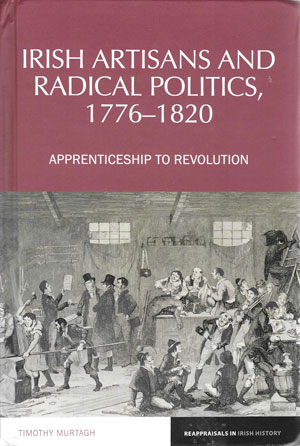IRISH ARTISAN AND RADICAL POLITICS, 1776–1820: APPRENTICESHIP TO REVOLUTION
Published in Book Reviews, Book Reviews, Issue 1 (January/February 2023), Reviews, Volume 31TIMOTHY MURTAGH
Liverpool University Press
£95
ISBN 97810802077148
Reviewed by Jim Smyth
Jim Smyth is Professor Emeritus at the University of Notre Dame.
Irish society and economy in the period 1776–1820 were, of course, overwhelmingly rural, and historians have duly reflected those past realities. By comparison, however, Irish urban history has until fairly recently received less attention, and yet cities in so many ways punched well above their modest demographic weight. Cities were centres of trade, manufacture, information, communications and political activity. Politics were often forged in what the American historian Gary Nash called the ‘urban crucible’ and exported to the countryside. And while it would be too crude—and not a little condescending—to say that the country simply took its politics from the town, in the 1790s there is a clear correlation between rural politicisation and proximity to urban political ‘hubs’. As one loyalist witness observed, Belfast has ‘poisoned every county within the circuit of its commerce’. Cork’s radicals, on the other hand, failed to proselytise their hinterland in a similar manner. In essaying explanations for that and other contrasts between Belfast, Cork and Dublin, Tim Murtagh’s original and well-made book in one respect offers penetrating studies in what did not happen.
The larger the city, the more opportunities it affords for sociability and associationalism. Taverns, coffee-houses, workplaces, street markets, theatres and guildhalls, along with newspapers, pamphlets, commercial transactions and social interactions, constitute a patchwork ‘public sphere’. In the case of eighteenth-century Dublin formal public life was conducted by the corporation, which included a common council comprised of the trade guilds. And in addition to an estimated 1,300 licensed and unlicensed public houses, the capital city also boasted a parliament, ‘the Castle’, courts and an inns of court, a university and an imposing barracks. Moreover, those built and symbolic establishments shaped the urban environment around them in practical ways. For instance, the parliamentary ‘season’ attracted aristocrats and gentry to town and, in an earlier, non-mythical, version of trickle-down economics, provided business for coach-builders, gold- and silversmiths and other luxury goods tradesmen. The College Green parliament provided a target for the Dublin ‘mob’, while in 1798, and again in 1803, the Castle stood as the strategic prize, coveted by revolutionary insurgents.
Accounts of popular protest tend to focus on agitations conducted by middle-ranking social formations: the master craftsmen (and employers) who supported Dr Charles Lucas in the 1740s, the more politically advanced Volunteers who campaigned for parliamentary reform and commercial protectionism in the 1780s and, in the early 1790s, the Society of United Irishmen, whose members belonged for the most part to the petit bourgeois and professional classes. The Volunteers, to be sure, worked with ‘plebian patriots’, and the United Irishmen initially with Dublin’s nascent political underground, but it is Murtagh’s principal contention that the artisans had agency, organisational autonomy and ‘their own form of radicalism distinct’ from their middle-class allies—and he drills down deep to vindicate that arresting thesis.
The economic predicament in which the eighteenth-century artisan—defined here as ‘skilled, mainly urban, craftsmen, owning their own tools, and having served apprenticeships’—found himself trapped invited a truly radical response. Traditionally, journeymen might reasonably have expected to one day become master craftsmen themselves and gain admission to their trade guild, but in this period the increasing mechanisation and capitalisation of production pushed that prospect further and further beyond their reach. Thus, rather than relying on older paternalist modes of shop-floor relations, they turned to the journeyman combination, a forerunner of the modern trade union, to protect their wages and settle their disputes. In 1780 the Irish parliament passed an act outlawing all combinations, superseding previous legislation directed only at specific trades. Up to 30,000 journeymen gathered in the Phoenix Park to protest the new law. Classical republicanism had no quarrel with the free market, in which combinations were deemed an encumbrance, and that conflict of interest led inevitably to (perhaps unresolvable) tensions between some bourgeois radicals and their ‘Hibernian Sans Culotte’ associates. And yet old paternalistic habits died slowly. Far from confronting hundreds of his workers on strike, Henry Jackson, a major Dublin industrialist, recruited them en masse into the ranks of the United Irishmen!
By then the United Irishmen had transformed into a mass-based revolutionary movement, mainly through the co-option of already existing Defender networks. Dublin’s political underground, including Defender lodges, journeymen secret societies and ‘a six penny Jacobin club’ off Castle Street, were likewise absorbed into that unstable coalition, and on paper the membership ran into the thousands. So why, then, did rebellion not happen in Dublin in 1798? The answer entails the arrest of key rebel leaders, a breakdown in co-ordination, the intelligence successes of the authorities and so on, but in the end it comes down to the fact that government recognised the strategic and emblematic importance of securing the capital every bit as keenly as the United Irishmen, and so the city was placed under close military lockdown. The planned insurrection never got off the ground.
Rich in detail and fresh in perspective, Apprenticeship to revolution makes a genuinely substantive contribution to both Irish and labour historiography.

















